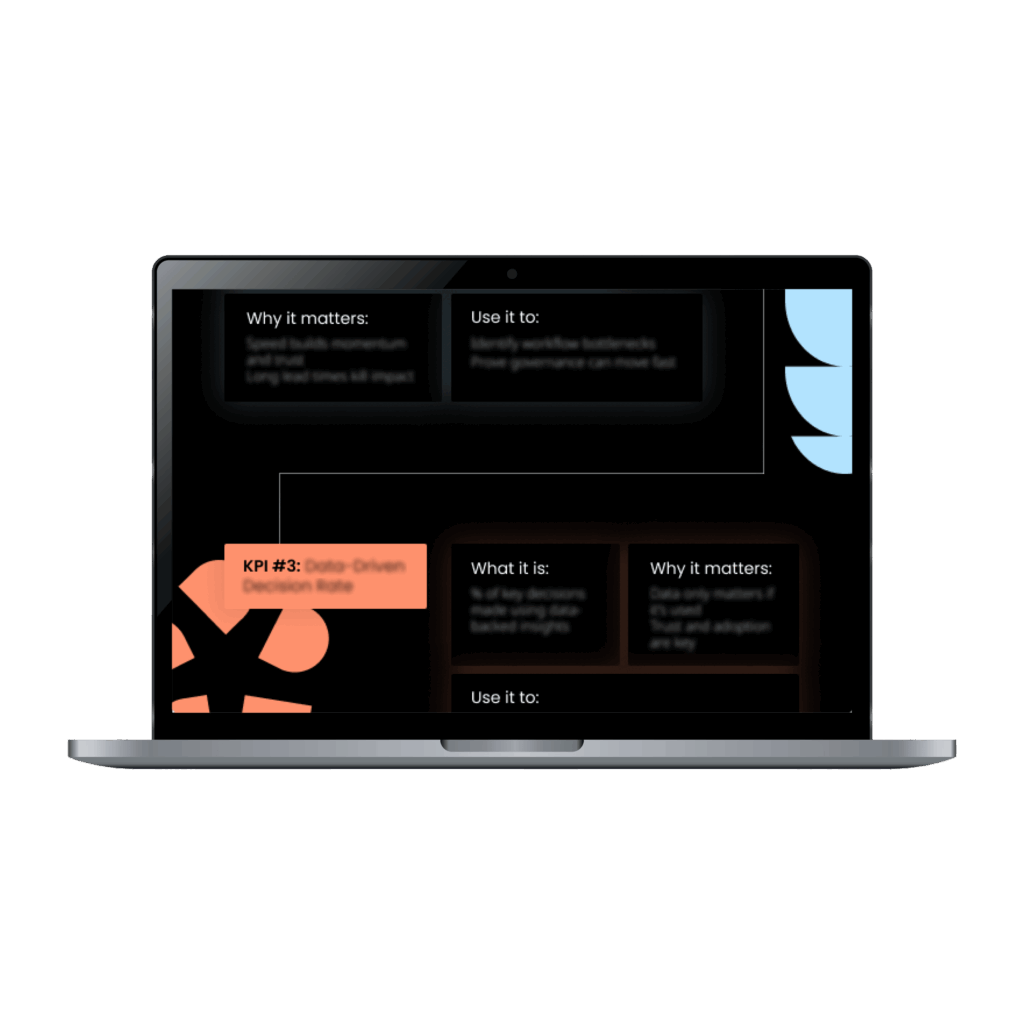
The power of semantic layers: Simplifying data complexity for faster, smarter decisions
We all know that using data well is key to success, but how can a semantic layer build on this success?
For modern businesses, having good data governance and management systems is a must. These tools help clarify data, support smart decisions, and improve business processes.
But as amazing as all this data is, it’s worthless if your teams don’t understand it.
Most professionals aren’t technical experts in data engineering or data analysis. However, that shouldn’t stop them from drawing insights from a business’ data.
To understand a company’s raw data, it’s crucial to provide a business-friendly view that allows anyone in your organization to quickly and easily find answers to their business questions.
This blog post will discuss how modern technology professionals can use a semantic layer to better understand the information stored in their data catalogs for smarter, data-driven decision-making.
TL;DR summary
As modern data landscapes become more complex, organizations struggle to deliver fast, trustworthy insights.
A semantic layer—sitting between raw data and analytics tools—translates technical datasets into consistent, business-friendly concepts. This unlocks self-service analytics, strengthens governance, improves AI performance, and ensures enterprise-wide alignment.
When paired with a data catalog and governed through a platform like DataGalaxy, the semantic layer becomes a foundation for scalable data & AI product governance.
What is a semantic layer?
A semantic layer is a function that connects complex data systems with business users by using everyday language and business terms, and keeps data consistent.
This makes data easier to understand and use for business needs.
Functions of the semantic layer
The semantic layer acts as a middleman between raw data and tools for end-users. It changes complex data into terms that are easy for business people to understand. Its main functions are:
- Providing a unified and consistent view of data across various platforms
- Enhancing data consistency and reliability for accurate business insights
- Simplifying data interaction by translating technical jargon into business terminology
- Supporting user-centric data exploration and analysis
Semantic layer key features
Good semantic layers have key features that simplify user experience, including:
- User-centric design: Made for business users, offering easy data access and handling
- Query translation: Changes complex data queries into terms that make sense for business
- Maintenance of a business glossary: Keeps all data terms and definitions the same across the company, improving data consistency and communication
With these features, semantic layers make data easy to get to and useful.
This helps in making better decisions by having consistent and reliable business terms.
Why semantic layers matter more now than ever
The pace at which organizations generate and consume data continues to accelerate. Data now flows from cloud warehouses, SaaS platforms, on-premise systems, APIs, IoT streams, and AI models—all expanding in volume, velocity, and variability.
Meanwhile:
- Business teams need faster insights
- Regulations around privacy, fairness, and AI transparency continue to evolve
- Data and analytics teams are overwhelmed by inbound requests
- AI initiatives demand clean, consistent, contextualized data
Designing data & AI products that deliver business value
To truly derive value from AI, it’s not enough to just have the technology.
Data professionals today also need a clear strategy, reasonable rules for managing data, and a focus on building useful data products.
Read the free white paper
In this environment, the traditional model—where only technical teams can interpret data—no longer works.
Semantic layers have emerged as a crucial capability. They decode complexity, ensure consistent definitions, and empower any user to confidently explore and use data.
As organizations shift toward data products and AI products, semantic layers act as a shared business language that supports governance, trust, and scalability.
Modern trends driving the need for semantic layers
1. Exploding data complexity
Organizations now manage data across:
- Cloud data platforms (Snowflake, Databricks, BigQuery)
- Operational databases
- SaaS applications
- Data lakes and lakehouses
- External APIs
- AI-generated synthetic datasets
This multi-system reality makes it harder to maintain consistency, lineage visibility, and trust.
2. Growing demand for self-service analytics
Business users want to explore data independently. But without context:
- They misinterpret metrics
- They create conflicting dashboards
- They rely too heavily on data teams
A semantic layer closes the knowledge gap.
3. Rising regulatory pressure
Laws such as:
- GDPR
- CCPA
- AI Act (EU)
- HIPAA
- Data sovereignty regulations
require consistent tracking of definitions, lineage, access rules, and bias mitigation—a perfect use case for semantic layers.
4. AI adoption requires clean, defined, and trustworthy data
Machine learning models depend on:
- Clear definitions
- High-quality features
- Consistent inputs
- Transparent lineage
Semantic layers dramatically improve model accuracy and reduce algorithmic risk.
How semantic layers solve these challenges
Simplifying & unifying data
Semantic layers standardize definitions across sources, eliminating:
- Conflicting KPIs
- Different interpretations of the same metric
- Duplicate reporting
- Version confusion
By consolidating definitions, organizations build a single source of semantic truth.

The 3 KPIs for driving real data governance value
KPIs only matter if you track them. Move from governance in theory to governance that delivers.
Download the free guideEnabling self-service analytics for everyone
Business users no longer need to:
- Understand SQL
- Navigate complex schemas
- Decode technical metadata
Semantic layers offer intuitive, business-friendly navigation and reduce dependency on engineering teams.
Strengthening governance, security, and ethical AI
Semantic layers serve as a control point for:
- Role-based access
- Data privacy rules
- Data minimization
- Lineage visibility
- Bias mitigation documentation
- AI transparency requirements
They ensure the right people access the right data in the right context.
Key features of an effective semantic layer
1. User-centric design
Built for business users, not engineers.
Intuitive exploration, searchable definitions, and clear context.
2. Query translation
Converts business terms into optimized queries for:
- BI tools
- Data science notebooks
- AI applications
This ensures accuracy and performance without user intervention.
3. Business glossary integration
A governance-ready glossary:
- Standardizes terms
- Reduces ambiguity
- Enables organization-wide alignment
4. Unified data abstraction
Consistent semantics across:
- Multiple clouds
- Multiple warehouses
- Multiple departments
Even when technical systems differ.
Ask questions. Get answers. Drive action.
Blink helps every user explore, understand, and use data in their daily work. No tickets, no filters, no delays.
Meet Blink!Benefits of implementing a semantic layer
Faster, higher-quality decisions
Teams benefit from:
- Consistent KPIs
- Clear lineage
- Simplified access
- Faster exploratory analysis
This reduces decision latency and increases the reliability of insights.
2. Stronger collaboration across departments
A shared business language enables:
- Clear communication
- Aligned definitions
- Fewer conflicting dashboards
- More productive cross-functional work
3. Improved AI accuracy & fairness
Semantic layers boost AI performance by:
- Standardizing features
- Reducing input variability
- Ensuring clean, governed datasets
- Documenting lineage for explainability
- Supporting compliance with AI regulations
4. Reduced data silos & simplified integration
By abstracting underlying data sources, semantic layers:
- Break silos
- Reduce integration overhead
- Accelerate onboarding of new systems
Semantic layer + data catalog: A winning combination
A data catalog organizes metadata, lineage, ownership, and classifications.
A semantic layer provides business meaning and governed access.
Together, they form a data & AI product governance ecosystem.
Combined benefits include:
- Unified visibility + unified meaning
- Accurate reporting
- Easier discovery and reuse
- Standardized enterprise definitions
- Full lineage from source to semantic to dashboard
Why every organization needs a semantic layer
A well-implemented semantic layer:
- Bridges the gap between data engineers and business teams
- Improves analytics consistency
- Reduces rework and reporting errors
- Strengthens governance and AI transparency
- Powers self-service analytics
- Aligns with data product and AI product methodologies
In a world overflowing with data, semantic layers are no longer optional—they are foundational for data-driven decision-making and trustworthy AI.
FAQ
- Do I need a data catalog?
-
If your teams are struggling to find data, understand its meaning, or trust its source — then yes. A data catalog helps you centralize, document, and connect data assets across your ecosystem. It’s the foundation of any data-driven organization.
👉 Want to go deeper? Check out:
https://www.datagalaxy.com/en/blog/what-is-a-data-catalog/ - Can I build my own data catalog?
-
You could, but you shouldn’t. Custom solutions are hard to scale, difficult to maintain, and lack governance features. Off-the-shelf platforms like DataGalaxy are purpose-built, continuously updated, and ready for enterprise complexity.
- How does a data catalog help with AI risk management?
-
A modern data catalog helps identify and track sensitive data, document lineage, and ensure data quality — all of which reduce AI-related risks. It also improves traceability across AI pipelines and enables proactive monitoring.
- How does a data catalog integrate with my existing tools?
-
Modern catalogs integrate with your full data ecosystem — from Snowflake to Power BI. DataGalaxy includes prebuilt connectors, APIs, and automation tools that make syncing metadata seamless and scalable.
👉 See supported integrations - Does the integration support semantic model governance?
-
Yes. Looker’s semantic models can be connected to DataGalaxy’s catalog, glossary, and ownership structure. This ensures consistency and transparency in how KPIs, metrics, and logic are defined—helping align business and technical teams around a single source of truth.
Key takeaways
- Semantic layers translate complex data into consistent, business-friendly terms.
- They enable self-service, governance, and AI readiness.
- When combined with a data catalog, they form a unified Data & AI product governance ecosystem.
- They reduce silos, accelerate insights, and strengthen enterprise trust in data.
- In a modern data landscape, semantic layers are essential—not optional.

